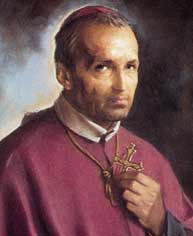
Back ألفونسو ليغوري Arabic الفونسو ليجورى ARZ Альфонс Марыя дэ Лігуоры Byelorussian Alfonso Maria de' Liguori Breton Alfons Maria de Liguori Catalan Alfons Maria z Liguori Czech Alfonso Maria de Liguori German Αλφόνσους Λιγκουόρι Greek Alfonso Maria de Liguori Esperanto Alfonso María de Ligorio Spanish
Alphonsus Liguori | |
|---|---|
| Bishop of Sant'Agata de' Goti Doctor of the Church | |
 | |
| Metropolis | Benevento |
| Diocese | Sant'Agata de' Goti |
| See | Sant'Agata de' Goti |
| Appointed | 14 June 1762 |
| Installed | 20 June 1762 |
| Term ended | 26 June 1775 |
| Predecessor | Flaminius Danza |
| Successor | Onofrio de Rossi |
| Orders | |
| Ordination | 21 December 1726 |
| Consecration | 20 June 1762 by Ferdinando Maria de Rossi |
| Personal details | |
| Born | 27 September 1696 Marianella, Campania, Kingdom of Naples |
| Died | 1 August 1787 (aged 90) Pagani, Campania, Kingdom of Naples |
| Denomination | Catholic Church |
| Sainthood | |
| Feast day |
|
| Venerated in | Catholic Church |
| Title as Saint | Bishop, Moral Theologian, Confessor and Doctor of the Church |
| Beatified | 15 September 1816 Rome, Papal States by Pope Pius VII |
| Canonized | 26 May 1839 Rome, Papal States by Pope Gregory XVI |
| Patronage | Pagani, Cancello, Naples (co-patron); arthritis, lawyers, confessors, moralists, vocations |
| Shrines |
|
Alphonsus Maria de Liguori, CSsR (27 September 1696 – 1 August 1787) was an Italian Catholic bishop and saint, as well as a spiritual writer, composer, musician, artist, poet, lawyer, scholastic philosopher, and theologian. He founded the Congregation of the Most Holy Redeemer, known as the Redemptorists, in November 1732.
In 1762 he was appointed Bishop of Sant'Agata dei Goti. A prolific writer, he published nine editions of his Moral Theology in his lifetime, in addition to other devotional and ascetic works and letters. Among his best known works are The Glories of Mary and The Way of the Cross, the latter still used in parishes during Lenten devotions.
He was canonized in 1839 by Pope Gregory XVI and proclaimed a Doctor of the Church by Pope Pius IX in 1871. One of the most widely read Catholic authors, he is the patron saint of confessors.[2][3]
- ^ Calendarium Romanum (Libreria Editrice Vaticana 1969), p. 99
- ^ Cite error: The named reference
Millerwas invoked but never defined (see the help page). - ^ Lives of St. Alphonsus Liguori (from "Vita di S. A. M. de Liguori"), St. Francis de Girolamo (from "Vita del B. Francisco di Girolamo dal Padre L. degli Oddi"), St. John Joseph of the Cross (from "Compendio della vita di Giangiuseppe, data in luce dal Postulatore della causa"), St. Pacificus of San Severino (from "Compendio della vita del B. Pacifico"), and St. Veronica Giuliani (from "Vita della B. Veronica Giuliani, da F. M. Salvatori"); whose canonization took place on Trinity Sunday, May 26th, 1839. C. Dolman. 1839.